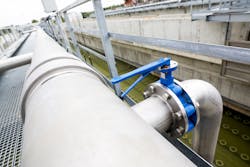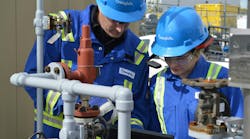Last month’s article described the sewage collection systems for two adjacent sewage districts. Sewage from the first sewage district and the combined sewage (sewage plus drainage water) from the second sewage district are treated in a sewage treatment plant owned and operated by the second sewage district.
It would be desirable to measure the flow from each sewage district in order to appropriately allocate the cost of operating the sewage treatment plant between the two districts. The amount of sewage generated by the first sewage district can be calculated by summing the flow measurements obtained by the four sewage flowmeters. However, these four sewage flowmeters emptied into the second district’s system at different locations, so the amount of sewage produced by the second sewage district alone could not be measured.
The total plant flowmeter measured the sewage from the first sewage district plus the sewage from the second sewage district plus the co-mingled drainage water from the storm drains in the second sewage district. Sewage flow normally varies throughout the day — increasing in the morning when people wake up, decreasing somewhat during the day when people are at work, increasing in the evening when people are home and then decreasing during the overnight hours when people are sleeping.
As a practical matter, sewage systems are not completely tight, so both systems will exhibit a certain amount of inflow and infiltration (I&I) during normal operation and (more so) during wet weather events — especially in the second sewage district system that is designed to collect drainage water. Therefore, normal sewage flow variation throughout the day plus relatively large amounts of drainage water that are periodically generated by the second sewage district require that the total plant flowmeter operate over an extremely wide range of flow rates.
Read more next month about how the sewage treatment plant operating costs are allocated.
David W. Spitzer is a principal at Spitzer and Boyes, LLC, which offers engineering, focused market research, writing/editing white papers, strategic marketing consulting, distribution consulting, seminars and expert witness services for manufacturing and automation companies. Spitzer has written more than 400 technical articles and 10 books about flow measurement, instrumentation and process control. He can be reached at 845-623-1830 or via spitzerandboyes.com.


